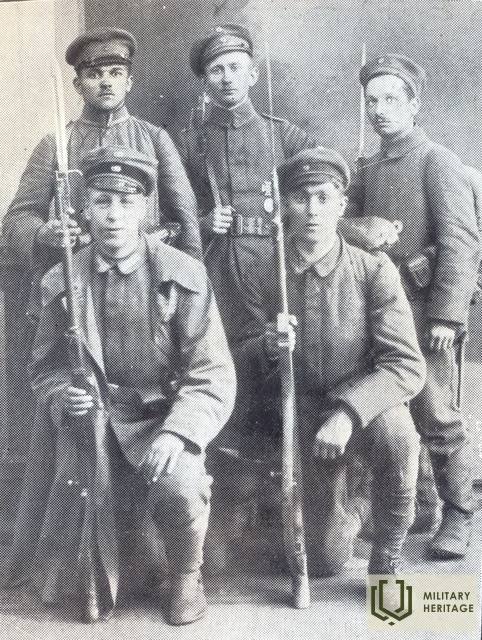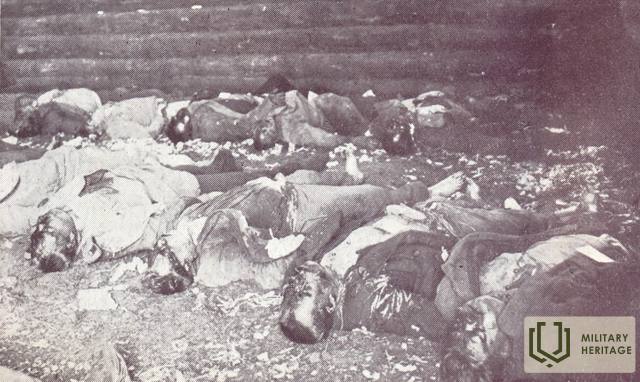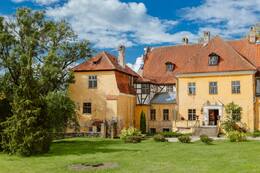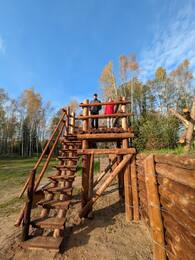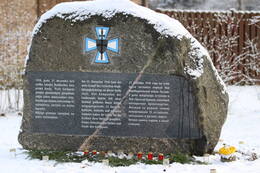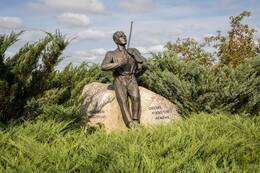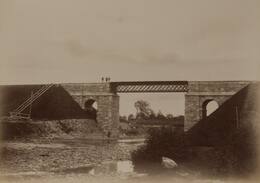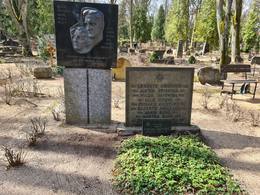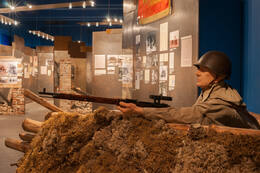Landeswehr. Baltische Landeswehr
I Unabhängigkeitskriege
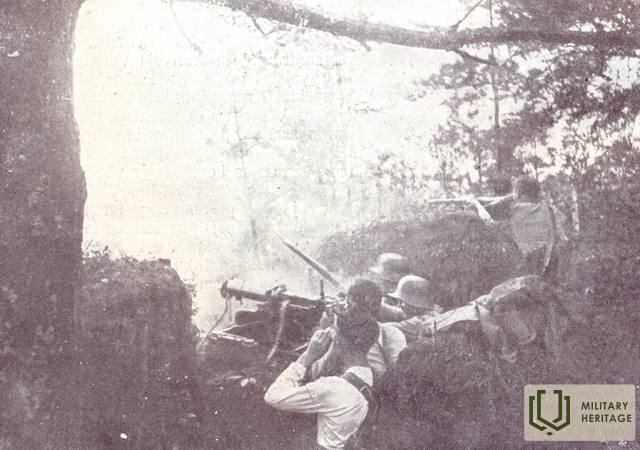
Landeswehr. Baltische Landeswehr (deutsch: Baltische Landeswehr, russisch: Балтийский ландесвер, englisch: Baltic Land Defence, Baltic Territorial Army, Baltic Home Guard)
Die Baltische Landeswehr war eine Selbstverteidigungsstruktur der Bewohner der deutsch besetzten baltischen Provinzen. Die Vorbereitungsarbeiten hierfür begannen im Frühherbst 1918, aber in der zweiten Novemberhälfte wurde sie in die Streitkräfte der neu gegründeten Republik Lettland – die Lettländische Landeswehr, umgangssprachlich „Landeswehr“ oder „Baltische Landeswehr“ genannt – eingegliedert.
Die multiethnische (aus Baltendeutschen, Letten und Russen bestehende) „Lettische Nationalgarde“ wurde mit deutscher Militärunterstützung zu den Streitkräften Lettlands. Administrativ unterstand sie dem lettischen Verteidigungsminister Jānis Zālītis, logistisch und militärisch jedoch der Führung der deutschen Besatzungstruppen. Die Vereinbarung zwischen der lettischen Regierung und dem deutschen Vertreter August Vinnig sah die Aufstellung der Nationalgarde auf freiwilliger Basis aus 18 lettischen, 7 deutschen und einer russischen Kompanie vor. Ursprünglich sollte der Kommandeur der Nationalgarde ein Vertreter eines neutralen Landes (Schweden) sein, doch dazu kam es nicht. Bereits Ende November hatte Vinnig aus den Soldaten der abziehenden deutschen Truppen die Eiserne Brigade (später Eiserne Division) aufgestellt, deren Soldaten gemäß der Vereinbarung vom Dezember die Möglichkeit hatten, die lettische Staatsbürgerschaft und Land zu erhalten.
Die Deutschen und Deutschbalten nannten die Truppen weiterhin Baltische Landeswehr, nicht Lettische Landeswehr. Die lettischen Kompanien, die sich innerhalb der Landeswehr formierten, wurden nach ihrem Aufstellungsort (Riga, Cēsis, Jelgava, Latgale) oder ihrer Zusammensetzung (Offizier, Rekrut) benannt. Oberstleutnant Oskars Kalpaks wurde zum Kommandeur der lettischen Einheiten ernannt.
Anfang Februar traf General Rüdiger von der Goltz in Liepāja ein. Er wurde zum Befehlshaber der deutschen Streitkräfte (zu denen die baltische Landeswehr und die Eiserne Division gehörten) in Kurland und Nordlitauen sowie zum Gouverneur von Liepāja ernannt. Am 16. April 1919 putschten in Liepāja Truppen unter Goltz' Kommando gegen die lettische Provisorische Regierung.
Die in der Baltischen Landeswehr vereinten Baltischen Deutschen unterstützten im Verlauf des Unabhängigkeitskrieges sowohl die vom Lettischen Volksrat unter Kārlis Ulmanis eingesetzte Provisorische Regierung als auch die illegale Regierung von Andrievs Niedra. Hatten deutsche und lettische Einheiten anfänglich das gemeinsame Ziel, Lettland von den Bolschewiki zu befreien, so richteten sich die Kampfhandlungen der Landeswehr und der deutschen Eisernen Division nach der Befreiung Rigas im Mai 1919 nicht mehr gegen die Bolschewiki, sondern gegen die Truppen Nordlettlands, die der legitimen Provisorischen Regierung Lettlands und der estnischen Armee treu ergeben waren. Nach den Schlachten von Cēsis, in denen die Landeswehr und die Eiserne Division besiegt wurden, setzten die dem lettischen Staat treu ergebenen Einheiten der Landeswehr den Kampf gegen die Bolschewiki fort. Am 30. März 1920 wurde die Landeswehr in das 13. Infanterieregiment „Tukums“ umgewandelt und der Division Kurzeme unterstellt. Am 1. April 1922 wurde das Regiment aufgelöst und die Soldaten dem 7. Sigulda-Infanterieregiment zugeteilt.
Die bekanntesten Kommandeure der Landeswehr waren Alfred Fletcher (1. Februar 1919 – 12. Juli 1919) und Harold Alexander (12. Juli 1919 – 18. Februar 1920).
Weitere Informationsquellen
Ēriks Jēkabsons. Lettischer Unabhängigkeitskrieg. Der Kampf der lettischen Provisorischen Regierung und ihrer Streitkräfte um die Unabhängigkeit Lettlands vom 18.11.1918 bis zum 11.08.1920. – Nationale Enzyklopädie: https://enciklopedija.lv/skirklis/22216-Latvijas-Neatkar%C4%ABbas-kar%C5%A1
Der Kampf um die Freiheit: Der lettische Unabhängigkeitskrieg (1918–1920) in den Dokumenten des Lettischen Staatlichen Historischen Archivs, Teil 1, 18. November 1918–16. April 1919, zusammengestellt von Ē. Jēkabsons und J. Šiliņš, Riga, Lettisches Nationalarchiv, 2019.
„Kampf um die Freiheit: Der lettische Unabhängigkeitskrieg (1918–1920) in den Dokumenten des Lettischen Staatlichen Historischen Archivs“ Teil 2. 16. April – 10. Juli 1919, hrsg. von Ē. Jēkabsons und J. Šiliņš, Riga, Lettisches Nationalarchiv, 2019.
Lettischer Freiheitskampf (siehe Literatur und externe Links). Wikipedia-Seite: https://lv.wikipedia.org/wiki/Latvijas_br%C4%ABv%C4%ABbas_c%C4%AB%C5%86as
Zugehörige Zeitleiste
Zugehörige Objekte
Das Denkmal erinnert an die Carnikavans, die 1919 von der Landeswehr erschossen wurden.
Im südwestlichen Eckbereich des Carnikava Parks, an der Kreuzung von Jūras Street und Nākotnes Street, zwischen zwei Eichen.
Ein Granitdenkmal für 12 Einwohner von Carnica, die im Frühjahr 1919 von deutschen Landeswehreinheiten getötet wurden, weil sie angeblich die „rote Gruppe“ besucht hatten.
Schloss Lielstraupe
Das Schloss Lielstraupe liegt im Zentrum von Straupe. Besucher können sich hier auf eine spannende Reise durch die Jahrhunderte und die Schloss-Labyrinthe begeben. 1919 während der Schlacht von Cēsis (dt. Wenden) befand sich im Schloss Lielstraupe der Befehlsstab einer Kampfgruppe der Eisernen Division unter Paul Ludwig Ewald von Kleist. Während der Kämpfe hielten sich zeitweise auch Major Bischoff und Hauptmann Guderian im Schloss auf. Von hier aus wurde der Angriff am 21. und 22. Juni 1919 in Richtung Stalbe geleitet. Die Eiserne Division war eine deutsche Söldnertruppe, die aus demobilisierten Soldaten der deutschen 8. Armee und Freiwilligen bestand. Sie operierte in Lettland während der lettischen Unabhängigkeitskämpfe. Sie war der bekannteste Teil der deutschen Freikorps und gehörte 1919 zu den am besten ausgebildeten und schlagkräftigsten Truppenteilen im Baltikum. Während der sowjetischen Herrschaft von 1949 bis 1959 befand sich die Verwaltung der Maschinen- und Traktorenstation im Gutshaus Lielstraupe. In dieser Zeit wurden im Schloss auch Schulungsräume und ein Wohnheim für Traktoristen eingerichtet. In den Gutsstallungen entstanden Werkstätten. Von 1963 bis 2018 beherbergte das Schloss medizinische Einrichtungen. Über die Narkologische Klinik Straupe pflegte man in Lettland zu sagen, dass hier selbst die „Wände verarztet werden“.
Museum der Weihnachtsschlachten
Das Museum befindet sich im Haus „Mangaļi“ in der Gemeinde Valgunde, Region Jelgava, und ist eine Zweigstelle des lettischen Kriegsmuseums. Es wurde 2005 am Ort der Weihnachtsschlachten des Ersten Weltkriegs eröffnet. An den Schlachtorten sind noch heute einzigartige Befestigungen aus dem Ersten Weltkrieg erhalten. Die Freilichtausstellung des Museums der Weihnachtsschlachten rekonstruiert einen Teil des Befestigungssystems – den Unterstand und einen Teil der ersten deutschen Verteidigungslinie – den „deutschen Wall“, der das einzige Objekt seiner Art im Baltikum ist.
Die Weihnachtsschlachten sind eines der bekanntesten und dramatischsten Ereignisse des Ersten Weltkriegs in Lettland. Sie nehmen einen besonderen Platz in der lettischen Militär-und Kulturgeschichte ein. Sechs Tage lang wurde heftig gekämpft, was zu schweren Verlusten führte. Die Schlachten sind vor allem mit dem Angriff der lettischen Schützen auf die deutsche Armee verbunden, der unter besonders harten und ungünstigen Winterbedingungen stattfand. Dies ist ein beispielloser Fall, in dem eine größere Kampfhandlung ohne Artillerieunterstützung durchgeführt wurde.
Heute beherbergt das Museum Artefakte, die auf den Schlachtfeldern gefunden wurden. Die Innenausstellung ist zu bestimmten Zeiten geöffnet, während die Außenausstellung der Festungsanlagen täglich geöffnet ist. In der Umgebung wurden touristische Routen und Naturlehrpfade angelegt.
Denkmal für die erste Schlacht um die Unabhängigkeit Lettlands
Das Hotel liegt in Inčukalns, Atmodas-Straße 2.
Am 3. Juli 2016 wurde ein Denkmal für die erste Schlacht um die lettische Unabhängigkeit enthüllt. Es ist der Lettischen Landeswehr gewidmet, in der damals einheimische Deutschbalten, Russen und Letten, die auf beiden Seiten in Einheiten dienten, den jungen Staat gegen die bolschewistische Rote Armee verteidigten. Eižens Upmanis, Vorsitzender des Komitees „Brüdergräber“, schlussfolgerte damals, dass dies das erste Denkmal für die vereinigten lettischen und deutschbaltischen Streitkräfte auf einem Schlachtfeld außerhalb der Friedhöfe sein könnte. Zu dieser Zeit wurde Oberstleutnant Oskars Kalpaks zum Kommandeur der lettischen Einheiten der Lettischen Landeswehr ernannt, aus denen später die Lettische Armee während des Freiheitskampfes hervorging.
1918 fiel das gesamte Gebiet des heutigen Lettlands in die Hände des Deutschen Reiches und seiner Truppen. Im Spätsommer und Herbst desselben Jahres wendete sich das Blatt jedoch rasch gegen Deutschland, und es war absehbar, dass die Niederlage im Ersten Weltkrieg nur noch eine Frage der Zeit sein würde. Das Russische Reich, zu dem Lettland bis zum Ersten Weltkrieg gehört hatte, war bereits mit den Februar- und Oktoberrevolutionen von 1917 untergegangen. Am 18. November 1918 wurde die Republik Lettland ausgerufen. Die deutsche Armee, die nach dem Waffenstillstand mit den Entente-Mächten am 11. November 1918 auf lettischem Gebiet stationiert war, hatte keine Motivation mehr für weitere Kampfhandlungen, und die meisten ihrer Soldaten wollten einfach nur in ihre Heimat zurückkehren.
Unter diesen Umständen war klar, dass die Verteidigung Lettlands in erster Linie von einer Nationalgarde abhing, die von der lettischen Bevölkerung selbst gebildet werden sollte. Aufgrund ihrer Bildung und ihrer vergleichsweise größeren Fähigkeit zur Selbstorganisation zeigten die in Lettland lebenden Deutschbalten zunächst die größte Initiative bei der Aufstellung einer solchen Nationalgarde. Auch russische Soldaten schlossen sich der Nationalgarde an. Um die Versorgung der Nationalgarde mit Uniformen, Waffen und anderen notwendigen Ausrüstungsgegenständen sicherzustellen, schloss die lettische Provisorische Regierung am 7. Dezember 1918 ein Abkommen mit dem deutschen Vertreter Augustus Vinnig ab, das die Bereitstellung der Nationalgarde aus den in Lettland stationierten deutschen Armeereserven vorsah. Dieses Abkommen legte unter anderem fest, dass diese Nationalgarde mit dem offiziellen Namen „Latvijas zemessardze“ oder auf Deutsch „die Lettländische Landeswehr“ die Streitkräfte der Republik Lettland bilden sollte.
Die lettische Nationalgarde stand zwei Regimentern der lettischen Roten Schützen (etwa 2.000–3.000 Soldaten) gegenüber, die bereits im Ersten Weltkrieg und im Russischen Bürgerkrieg Kampferfahrung gesammelt hatten. Trotz der Erfahrung und zahlenmäßigen Überlegenheit der Roten Armee hielt die lettische Nationalgarde Inčukalna zwei Tage lang in erbitterten Kämpfen, bis sie schließlich am Abend des 1. Januar 1919, um einer Einkesselung zu entgehen, zum Rückzug gezwungen war. Dabei verlor sie 43 Mann, und mehrere wurden verwundet. Die meisten von ihnen gerieten in bolschewistische Gefangenschaft und starben dort, entweder durch Tod, Hunger oder Krankheiten.
Künstler: Artis Buks. Material: Feldstein. Das Denkmal besteht aus einem großen monolithischen Stein, der in Ruļļi bei Jelgava gefunden wurde.
Heimathof „Liepsalas“ von Oberst Oskars Kalpaks und seine Grabstätte auf dem Friedhof Visagals
Die Erinnerungsstätte am Geburtshaus „Liepsalās“ von Oberst Oskars Kalpaks befindet sich in der Gegend zwischen Madona und dem Lubāns-See. Die Gedenkstätte entstand 1997 nach den Vorstellungen und aus Mitteln der Nichte von Oberst Kalpaks, Ārija Kalpaks-Grundmane (1922-2006). Die Anlage besteht aus verschiedenen Naturobjekten und Steinskulpturen mit symbolischen Anspielungen auf die ethischen und patriotischen Werte der Letten. Im größten Gebäude entstand eine Ausstellung über die lettischen Freiheitskriege und die 22 Jahre der Freiheit in Lettland (1918-1940). Auf dem Friedhof von Visagals steht ein Denkmal für Oskars Kalpaks, das 1927 von Kārlis Zāle und Arnolds Dzirkalis geschaffen wurde. Es handelt sich um eine Komposition aus drei Figuren: einem altlettischen Krieger mit Schwert und Schild im Zentrum und jeweils einem niedergesunkenen Soldaten zu beiden Seiten. Am Fuße der Skulpturengruppe ist eine Bronzetafel auf einem geneigten Granitsockel angebracht, in die ein Text eingraviert ist, der ein Kalpaks´ gewidmetes Gedicht von Edvards Virza enthält. Oskars Kalpaks fiel am 6. März 1919 bei Airite, an der Verbindungsstraße zwischen Skrunda- und Saldus.
Eisenbahnbrücke über Amata
Liegt in der Gemeinde Drabeši, Region Cēsis, in der Nähe des Erholungsgebiets „Meža koujas“.
Eine Eisenbahnbrücke über den Fluss Amata ist zu sehen.
Die Eisenbahnbrücke über den Fluss Amata spielte im Unabhängigkeitskrieg eine entscheidende Rolle, da hier am 5. Juni 1919 die erste Schlacht zwischen den Panzerzügen der estnischen Armee und den Einheiten der baltischen Landeswehr stattfand. Die Landeswehr, die von der Annäherung des Panzerzugs wusste, verminte die Brücke und bezog Stellung in den Häusern der Stadt „Amata“ am Flussufer, um für mögliche Kampfhandlungen bereit zu sein. Die Brücke über die Amata bildete die Grenze zwischen den estnischen und den deutschen Streitkräften.
Historische Zeugnisse der Ereignisse an der Amata-Brücke sind nicht erhalten geblieben. Da Letten nicht teilnahmen, existieren keine Erinnerungen von ihnen, wohl aber von estnischen Soldaten und aus anderen Quellen. Man kann von einer gemeinsamen estnisch-amerikanischen Schlacht gegen die Landeswehr sprechen, da sich ein amerikanischer Offizier, der später im Zweiten Weltkrieg kämpfte, in einem estnischen Panzerzug befand. Generell nahmen viele spätere Offiziere und Kommandeure des Zweiten Weltkriegs an den Schlachten bei Cēsis teil, insbesondere auf deutscher Seite.
Der estnische Panzerzug erreichte Cēsis am 2. Juni 1919 und fuhr einen Tag später nach Ieriķi, wo Verhandlungen mit der Landeswehr stattfanden, die jedoch ergebnislos verliefen. Am 5. Juni, als sich der Panzerzug erneut der Amata-Brücke näherte, kam es zu einem Gefecht mit den Deutschen. Der Panzerzug nahm auch an den Kämpfen bei Cēsis einen Tag später teil und unterstützte die Soldaten der Schulkinderkompanie, die von der Einkesselung bedroht waren. Obwohl die Deutschen versuchten, die Gleise zu demontieren, um dem Zug den Rückzug abzuschneiden, gelang ihm die Flucht über die Rauna-Brücke.
In der Nacht des 23. Juni 1919, während der Schlacht um Cēsis, gab die Landeswehr Cēsis auf und zog sich zum Fluss Amata zurück. Auf dem Rückzug brannten die Deutschen das Gebäude der Lettischen Gesellschaft von Cēsis nieder und sprengten die Brücke über die Amata.
Denkmal für den ersten gefallenen Soldaten der Schulkompanie, Edgars Krieviņš
Das Gelände befindet sich auf dem Friedhof im Stadtzentrum von Valmiera, in der Nähe der Kapelle (Miera Street 1/3, Valmiera).
Ein Soldat der 8. (Studenten-)Kompanie des Cēsis-Regiments, LKOK Edgars Krieviņš (1899-1919), starb am 7. Juni an Verletzungen, die er sich in der Schlacht von Cēsis am 6. Juni 1919 zugezogen hatte, als er beim Angriff des Feindes den Rückzug der übrigen Einheiten deckte.
Lettisches Kriegsmuseum
Das Lettische Kriegsmuseum befindet sich in der Altstadt von Riga, in der Nähe des Freiheitsdenkmals. Es ist im Pulverturm untergebracht, einem alten Verteidigungsbau. In insgesamt 11 Ausstellungen präsentiert das Museum Waffen, Dokumente, Uniformen, Auszeichnungen und andere Gegenstände, die mit dem Krieg- oder Soldatenalltag zu tun haben. Das Lettische Kriegsmuseum ist eines der ältesten Museen Lettlands. Seine Anfänge gehen auf den Ersten Weltkrieg zurück. Die Basis der Museumssammlungen bilden auf den Schlachtfeldern gefundene zum Teil persönliche Gegenstände von Soldaten. Nach der Gründung des lettischen Staates ging es darum, eine Ausstellung über die Militärgeschichte Lettlands sowie über die aktive Rolle der Staatsbürger bei der Verteidigung ihres Landes zu schaffen. 1937 wurde das Museum durch einen Anbau vergrößert und zählte technisch gesehen damals zu den modernsten Museen in Europa. Der Pulverturm ist einer der Türme der früheren Rigaer Stadtbefestigung. 1330 wurde er als „Sandturm” erwähnt. Bei der Belagerung Rigas durch schwedische Truppen 1621 wurde der Turm zerstört. 1650 wurde ein neuer Turm zur Lagerung von Schießpulver und Waffen gebaut. Nach dem Abriss der Stadtmauer mit ihren Türmen bildet der Pulverturm heute eines der wertvollsten Zeugnisse des städtischen Verteidigungssystems.
Zugehörige Geschichten
Anfang, Verlauf und Ende der Schlacht von Cēsis
Der Sieg in der Schlacht bei Cēsis sollte sich als Wendepunkt im lettischen und estnischen Kampf um die Unabhängigkeit ihres Landes erweisen. Er beendete die Pläne der Regierung von Andrievs Niedra und des deutschen Generals Rüdiger von der Goltz zur Eroberung des Baltikums. Stattdessen nahm die lettische Provisorische Regierung unter Kārlis Ulmanis ihre Tätigkeit in Liepāja wieder auf.
Über den Nationalpatrioten Oberleutnant Vili Gelbi
Das Schicksal von Oberstleutnant Vilis Gelbe (1890–1919) spiegelt die schwierige Situation bei der Bildung unseres Staates und unserer Armee sowie die Bewertung dieser Ereignisse wider.
Mit der Ausrufung des lettischen Staates am 18. November 1918 begann der Lettische Unabhängigkeitskrieg und der Aufbau der Streitkräfte. In den ersten Reihen der lettischen Freiwilligensoldaten stand der aus Kurland stammende Marineleutnant Vilis Gelbe.
Gut Aizporis während des Unabhängigkeitskrieges
Das Halbgut Aizporu, Kreis Aizpute, Gemeinde Kalvene, ist der westlichste Ort in Lettland, in den sich das Separatistenbataillon von Oberst Oskars Kalpaks zurückzog.
Auf halbem Weg zwischen Rudbārži und Kalvenė liegt am Straßenrand der Friedhof von Aizpore. Dort befinden sich ein Denkmal und 12 Gedenkstätten für die freiwilligen Soldaten des Bataillons von Oskars Kalpaka.




